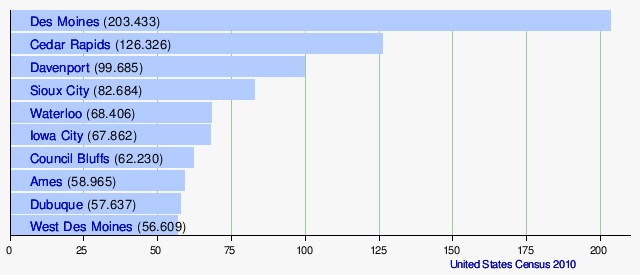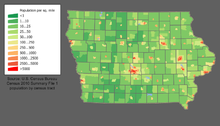Iowa
![]()
The title of this article is ambiguous. For other meanings, see Iowa (disambiguation).
Iowa (English pronunciation [![]()
![]() ˈaɪ̯əwə]) is the 29th state of the United States of America since joining the Union on December 28, 1846. The state is located in the Midwest and is known for growing corn and its vast outdoors. Exceptions to the village and small town structure are only the major regions around Des Moines, Cedar Rapids, Davenport and Sioux City.
ˈaɪ̯əwə]) is the 29th state of the United States of America since joining the Union on December 28, 1846. The state is located in the Midwest and is known for growing corn and its vast outdoors. Exceptions to the village and small town structure are only the major regions around Des Moines, Cedar Rapids, Davenport and Sioux City.

Iowa State Capitol, seat of the State Legislature (2013)
Geography
Geographical location
Iowa is located in the Midwest of the USA. The state borders Minnesota to the north, Nebraska and South Dakota to the west, Missouri to the south, and Wisconsin and Illinois to the east.
The Mississippi River forms the eastern border of the state. In the west, river courses also form the state border - south of Sioux City it is the Missouri River, north of it the Big Sioux River. The topography of the state is characterized by rolling plains. Loess uplands are found along the western border, some several hundred feet thick. Among the few naturally formed lakes are the so-called Iowa Great Lakes - namely Big Spirit Lake, East Okoboji Lake, and West Okoboji Lake, among others. They are located in the northwestern part of the state, close to the Minnesota border.
Iowa's annual rainfall decreases toward the northwest. The more forested areas of the south and east transition to the tallgrass prairie of the Great Plains to the north and west.
The lowest point is the Mississippi River at Keokuk in southeastern Iowa (175 m); the highest point is Hawkeye Point (509 m). In relation to the area, the differences in altitude are small.
With a total area of 145,743 km², Iowa ranks 26th in the middle of all US states by area size. 1,042 km² (0.71 percent) of the state are water areas.
Extension of the national territory
Iowa extends over a latitude of 320 km from 40°36'N to 43°30'N and has a longitude of 500 km from 89°5'W to 96°31'W.
Structure
- List of counties in Iowa
Population
| Population development | |||
| Census | Inhabitants | ± in % | |
| 1840 | 43.112 | - — | |
| 1850 | 192.214 | 345,8 % | |
| 1860 | 674.913 | 251,1 % | |
| 1870 | 1.194.020 | 76,9 % | |
| 1880 | 1.624.615 | 36,1 % | |
| 1890 | 1.912.297 | 17,7 % | |
| 1900 | 2.231.853 | 16,7 % | |
| 1910 | 2.224.771 | −0,3 % | |
| 1920 | 2.404.021 | 8,1 % | |
| 1930 | 2.470.939 | 2,8 % | |
| 1940 | 2.538.268 | 2,7 % | |
| 1950 | 2.621.073 | 3,3 % | |
| 1960 | 2.757.537 | 5,2 % | |
| 1970 | 2.824.376 | 2,4 % | |
| 1980 | 2.913.808 | 3,2 % | |
| 1990 | 2.776.755 | −4,7 % | |
| 2000 | 2.926.324 | 5,4 % | |
| 2010 | 3.046.355 | 4,1 % | |
| Estimate 2018 | 3.156.145 | 3,6 % | |
| Before 1900 1900–1990 2000 | |||
Iowa has a population of 3,156,145 (2018 estimate), of which 88.7 percent are white, 5.0 percent are Hispanic or Latino, 2.9 percent are black or African American, 1.7 percent are Asian American, and 0.4 percent are descendants of Native Americans.
Most Iowa residents have European ancestors. The ethnic Germans are by far the largest group with about 36 percent (2014). The Amana Colonies on the Iowa River still have a German influence today.
Religions
The largest religious community in Iowa is the Roman Catholic Church, to which about 23 percent of the population belong. The individual Protestant denominations are significantly less strongly represented. However, if the various Protestant groups are added together, Iowa is more Protestant. The religious denominations with the most members in 2000 were the Catholic Church with 558,092, the Evangelical Lutheran Church in America with 268,543, and the United Methodist Church with 248,211 adherents.
Known became the building "Trinity Church" of the village of Manning. Because of the reduced congregation, it was laboriously transported on a flatbed truck to a place 10 km away.
When asked "What is your religion?" in 2001, Iowa residents answered:
- 23 % Catholics
- 16 % Lutherans
- 13 % Methodists
- 6 % other
- 5 % no answer
- 5 % Baptists
- 5 % Christians
- 3 % Presbyterian
- 2 % Protestants
- 2 % Pentecostalism
- 2 % Congregationalists/United Church of Christ
- 1 % Church of Christ
Largest cities

See also: List of localities in Iowa

Population density
Questions and Answers
Q: What is the name of the state in the Midwestern United States?
A: The state in the Midwestern United States is Iowa.
Q: Where does the name Iowa come from?
A: The name Iowa comes from the Iowa River, which was named after the Ioway people, one of the Native American tribes that lived in Iowa.
Q: How did Iowa become part of the United States?
A: Iowa became part of the United States as part of the Louisiana Purchase.
Q: What kind of settlers were mostly found in Iowa?
A: Most settlers in Iowa were farmers. It is part of the Corn Belt and is often known as "the Food Capital of the World."
Q: What is Iowa's capital and largest city?
A: The capital and largest city in Iowa is Des Moines.
Q: When did Iowa become a state?
A:Iowa became a state on December 28, 1846, making it 29th state to join the United States.
Q: How many people live in Iowa according to 2010 census data?
A: According to 2010 census data, there are more than 3 million people living inIowa.
Search within the encyclopedia